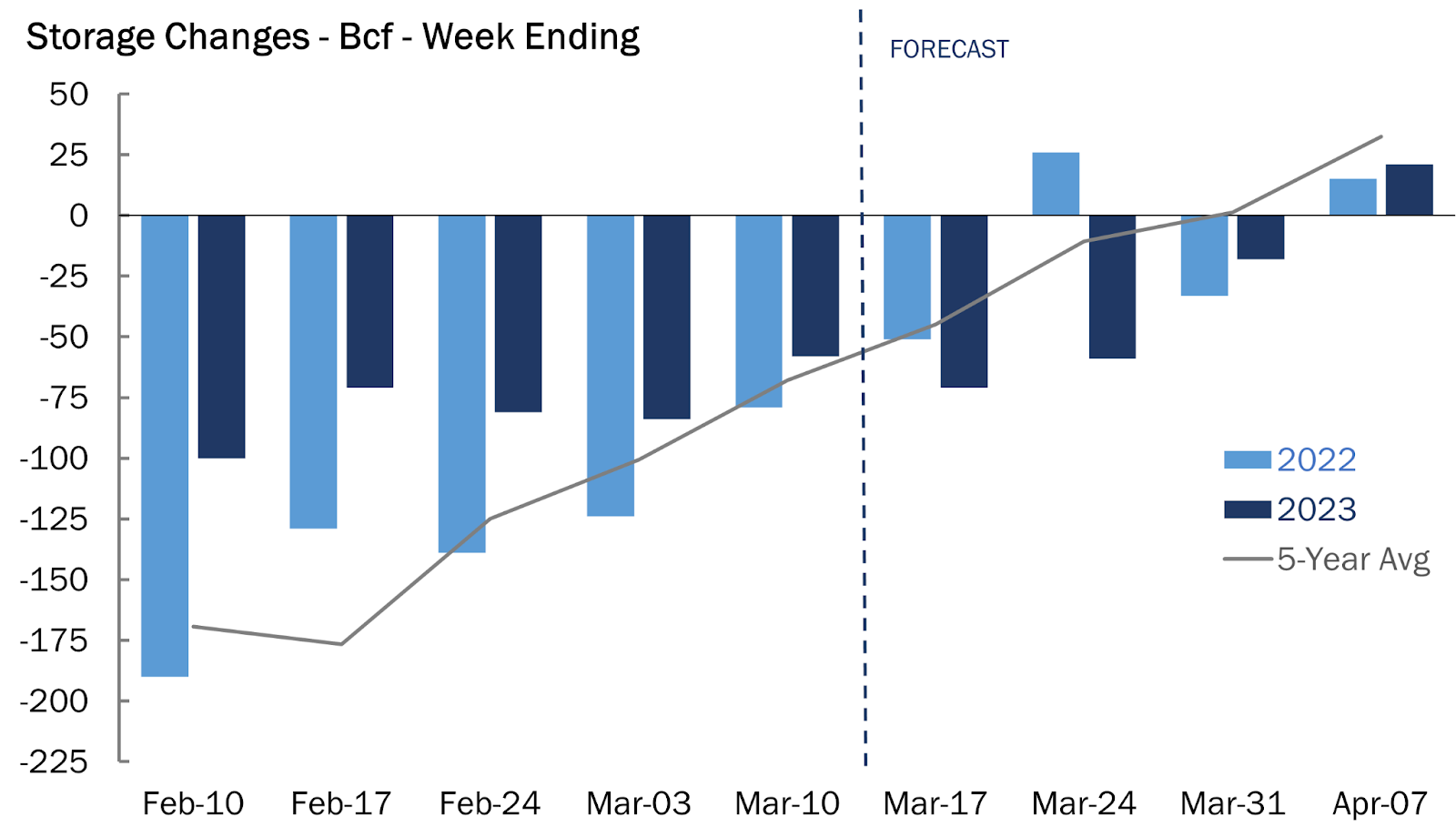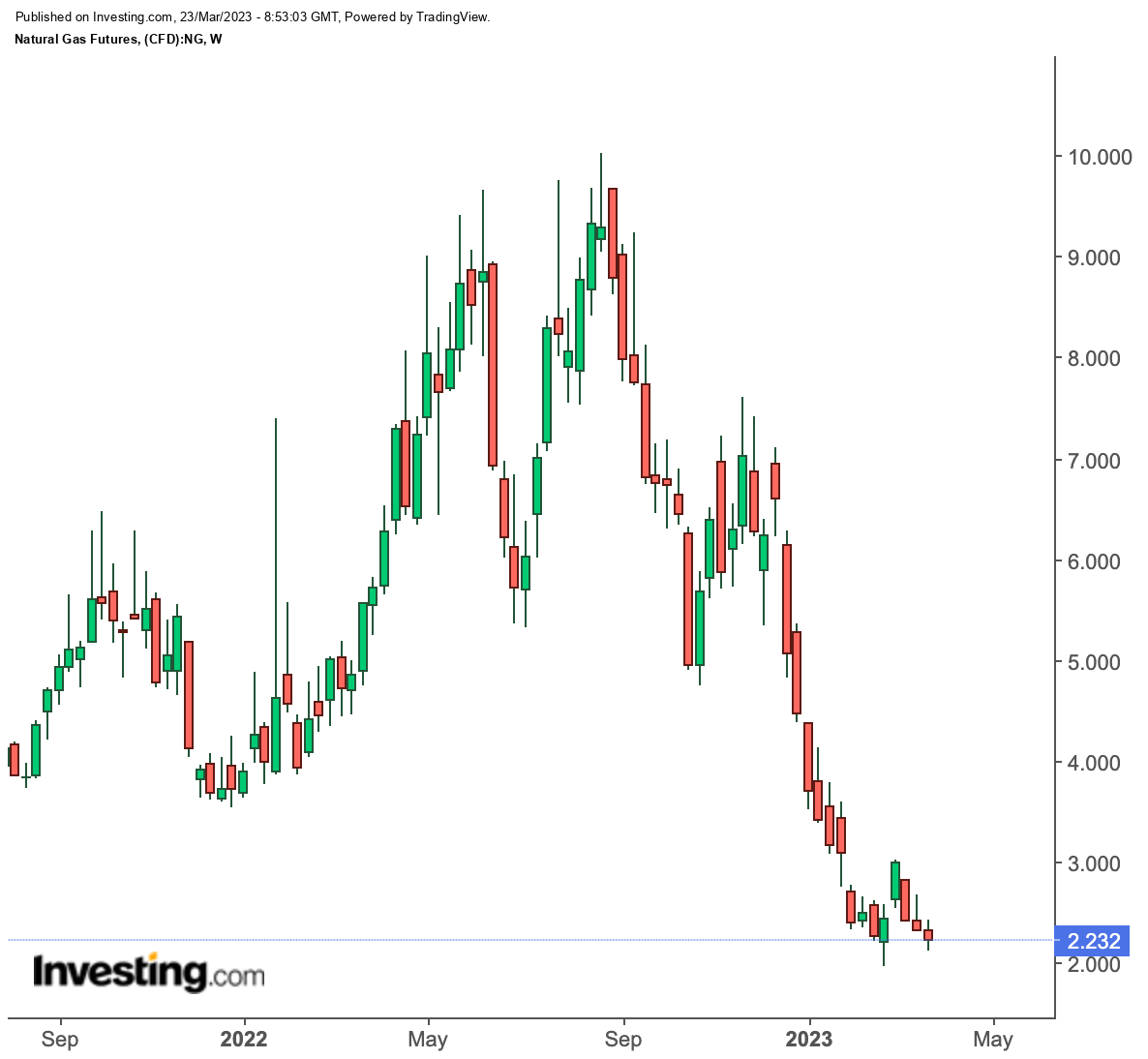- Gas market at pivotal stage between end of storage draws and start of injection
- The just-ended winter, one of the warmest, has left incredible gas balances
- Challenge now is for front-month gas to stay above $2
‘Put Your Head on my Shoulder’ says Paul Anka in his 1960 song, where he tells his lover he’s ready to support her any way she wants.
A few weather forecasters appeared to be offering similar love to natural gas longs this week, saying even with the end of winter, temperatures might be cool enough to generate a little heating demand as the market experiences its own ‘shoulder season’.
In gas market terminology, the ‘shoulder months’ are the months just before and after summer, i.e., March through April and September through October.
Since temperatures are usually more moderate in late spring and early fall, fewer people rely on gas to heat and cool their homes during those times.
With 2022/23 winter already being one of the warmest on record, the current shoulder season should actually be a greater demand killer for gas.
Yet, judging from the temperature calls made by some forecasters on Wednesday, there could be a little hangover chill from the just-ended winter — which had its last day on Monday — to make it through the next few weeks.
That should theoretically lead to more burns of gas in storage for heating, before the start of the so-called ‘injection period’ for gas where producers of the fuel would start filling underground holding caverns for the fuel with more supply.
Houston-based energy markets advisory Gelber & Associates said in a note issued Wednesday:
“Cooler temperatures will be bullish for the remainder of the withdrawal season’s storage withdrawals”.
Gas draws were projected to last another 3 weeks before the start of the injection season, Gelber said. Typically, the injection season comes after large withdrawals of gas from storage over a stretch of eight to 10 weeks.
The just-ended winter, however, has left incredible gas balances in those caverns.
The US Energy Information Administration, or EIA, said storage totaled 1.972 tcf, or trillion cubic feet, as of March 10. That was up 36% from the year-ago level of 1.451 tcf and 24% higher than the five-year average of 1.594 tcf. Any additions during the injection season will only add to those eye-watering levels.
 Source: Gelber & Associates
Source: Gelber & Associates
Forecaster NatGasWeather said in a projection carried by industry portal naturalgasintel.com:
“National demand will ease to light levels the next few days as warm high pressure sets up from Texas to the Northeast with highs of upper 50s to 80s.
There will be moderate demand this weekend as numerous weather systems impact the US, then a little further stronger next week as cool to cold weather systems sweep across the western, central and northern US.”
Rystad Energy analyst Ade Allen said was quoted saying on the same naturalgasintel report:
“Residential and commercial demand, the primary driver for keeping winter demand elevated and balances in check, has been extremely lackluster since the start of 2023.”
What’s more, “dry gas production has been relatively stable in the recent months,” Allen said, adding that Rystad expected production to again average above 100 bcf per day for the first three months of the year.
Analysts are divided on whether producers would pull back later this year. But most expect output to remain relatively strong with new infrastructure in the works and LNG, or liquefied natural gas, facilities coming online next year to meet strong export demand from both Europe and Asia.
As the market moves deeper into the shoulder season, “limp demand is not enough to keep up with growing supply, and the chances of that balance finding equilibrium is minimal at best,” said Allen.
The mixed readings from weather forecasters add a measure of uncertainty to what the EIA could report as the gas balance for the latest week to March 17.
Ahead of today’s weekly inventory report from the agency at 10:30 ET (14:30 GMT), a Reuters poll suggested that US utilities likely pulled a larger-than-usual 75 bcf, or billion cubic feet, from storage last week as cooler-than-normal weather increased heating demand.
In the week ended March 10, utilities pulled 58 bcf of gas from storage.
There were around 149 heating degree days (HDDs) last week, which was more than the 30-year average of 130 HDDs for the period, according to Reuters-associated data provider Refinitiv.
HDDs measure the number of degrees a day's average temperature is below 65 degrees Fahrenheit (18 degrees Celsius) to estimate demand to heat homes and businesses.
If correct, the latest draw would be larger than the 55-bcf pull during the same week a year ago and the five-year (2018-2022) average decline of 45 bcf.
The forecast for the week ended March 17 would cut stockpiles to 1.897 tcf, barely changed from the week ended March 10.
The challenge for gas longs, however, will be keeping the front-month gas contract on the New York Mercantile Exchange’s Henry Hub at the $2 per mmBtu, or million metric British thermal units, mark.
After staying at mid-$2 levels over the past month, Henry Hub’s front-month fell into the lower end of the range this week, touching $2.127 on Tuesday — the lowest since its foray to sub-$2 levels in February — before rebounding in this morning’s trading.

Technical charts for the front-month contract did not look too promising, said Sunil Kumar Dixit, adding:
“The short term trend looks bearish, though casual swings within $2.50 and $2.20 may be witnessed.
On a broader perspective, we continue to maintain our bearish outlook as long as prices sustain below $2.60 barrier and chances of a break below $2.22 and $2.12 are high, leading to potential drop towards $1.96 over an extended period of time.”
Thursday’s trading range itself was expected to be between the support of $2.22 and resistance of $2.48, Dixit said.
***
Disclaimer: Barani Krishnan uses a range of views outside his own to bring diversity to his analysis of any market. For neutrality, he sometimes presents contrarian views and market variables. He does not hold positions in the commodities and securities he writes about.

